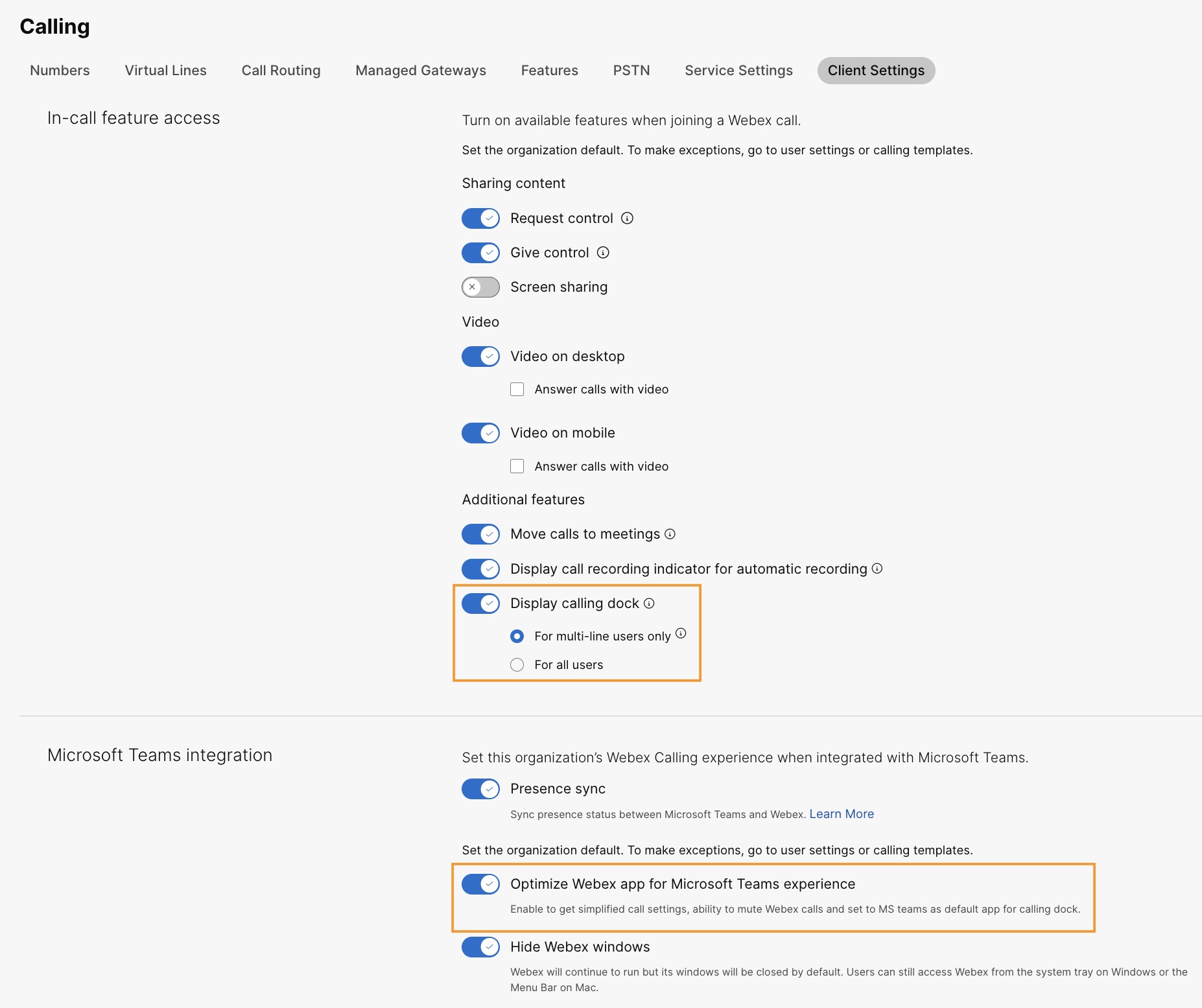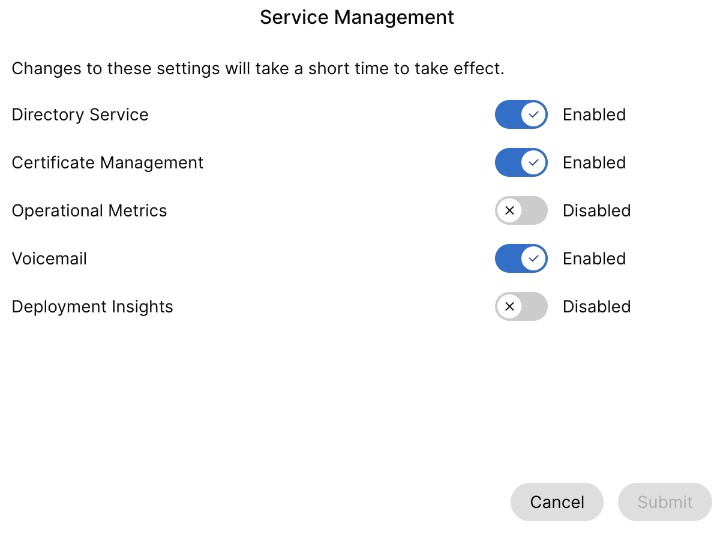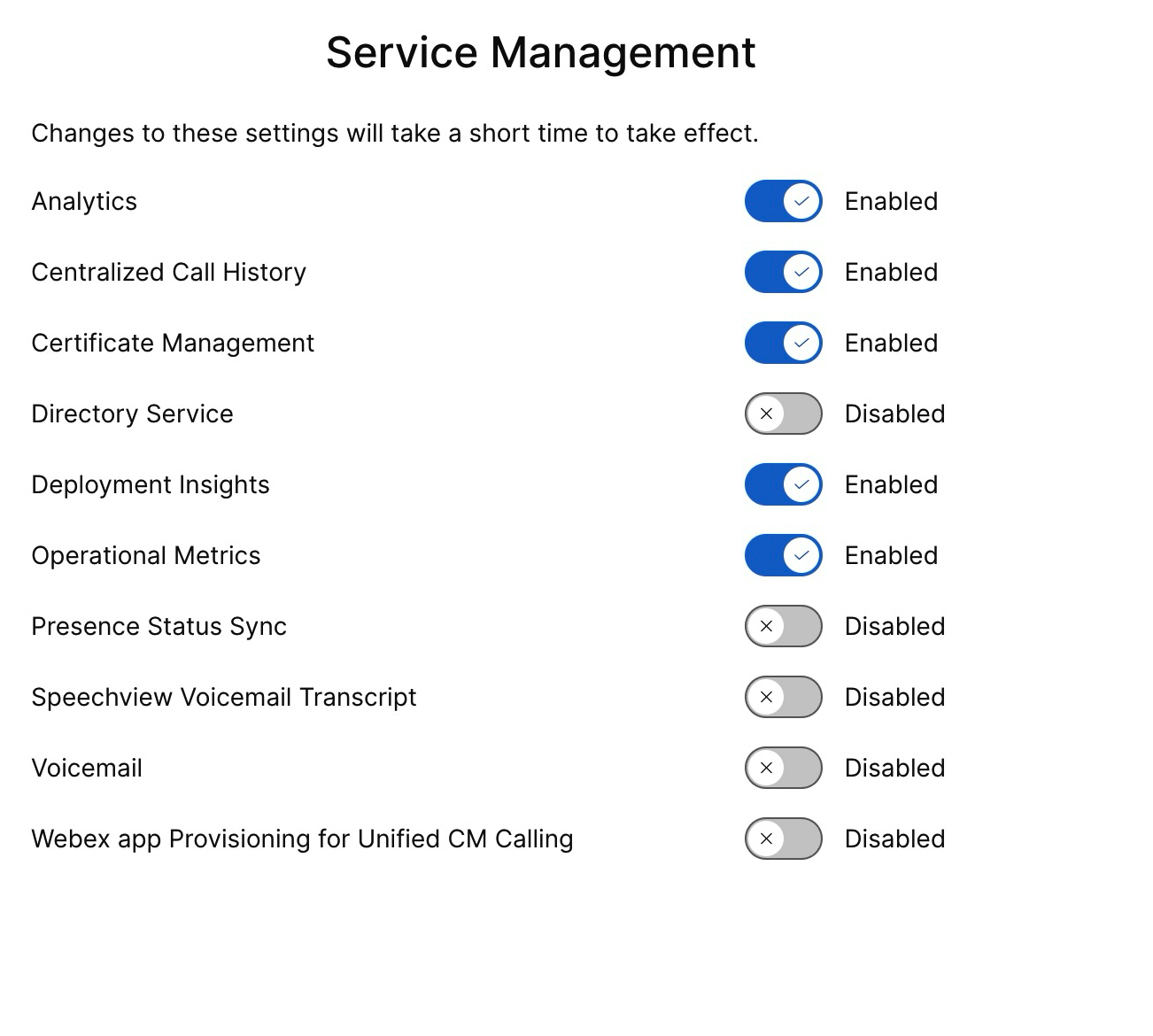- ホーム
- /
- 投稿記事



Microsoft Teams 用の Cisco Call を構成する
 この記事の内容
この記事の内容 フィードバックがある場合
フィードバックがある場合組織内のすべてのユーザーのデフォルトの通話オプションとして Cisco Call をインストールします。
この記事を使用して、Cisco Call オプションを使用して Microsoft Teams アプリを構成します。 ![]() アイコンが左側のナビゲーションとメッセージング拡張機能として追加されます。Teams 通話オプションをオフにすると、組織内の全員が同じプラットフォームを使用して通話の受発信を行います。
アイコンが左側のナビゲーションとメッセージング拡張機能として追加されます。Teams 通話オプションをオフにすると、組織内の全員が同じプラットフォームを使用して通話の受発信を行います。
前提条件
-
Microsoft Teams 管理者であることを確認してください。
-
コントロール ハブにアクセスできることを確認してください。
-
ユーザーに Control Hub でライセンスが割り当てられており、通話を行うために Cisco Unified Communications Manager または Webex Calling に登録されていることを確認します。
-
ユーザーには Webex アプリと Microsoft Teams がインストールされている必要があります。
-
Cisco Call for Microsoft Teams 統合を Unified CM コール制御バックエンド (オンプレミス、Webex Calling 専用インスタンス、または UCM Cloud) で動作させるには、Unified CM 12.5 SU7 または 14 SU3、Cisco Unity Connection (CUC) 12.5 または 14 を使用していることを確認してください。
-
オンプレミスのUnified CMの顧客の場合、Unified CMが & CUC クラスターは、Webex Cloud-Connected UC (CCUC) にオンボードされます。
-
ユーザーは、オンプレミスの Active Directory または Azure などの Cloud AD から Control Hub Common Identity (CI) に同期される必要があります。
-
オンプレミス、Webex Calling 専用インスタンス、および UCM Cloud のお客様の場合、 Cisco Unified CM を構成する—集中通話履歴にユーザー名を入力するには、Cisco Unified CM の回線番号をユーザー ID に関連付ける必要があります。Cisco Unified CM 管理から、デバイス→電話を使用して電話を選択し、デバイス名 (回線)をクリックし、関連付けパネルから必要な回線をクリックして、回線に関連付けられたユーザーに移動します。
-
Unified CM メール ID が、Universally Unique Identifier (UUID) を取得するために使用される Control Hub プライマリ電子メール と一致していることを確認します。
-
仮想デスクトップ インフラストラクチャ (VDI): VDI 環境で Cisco Call と Microsoft Teams の統合を使用する場合、Cisco Call と Microsoft Teams の両方が同じ仮想マシンで実行されている必要があります。
Microsoft Teams の構成
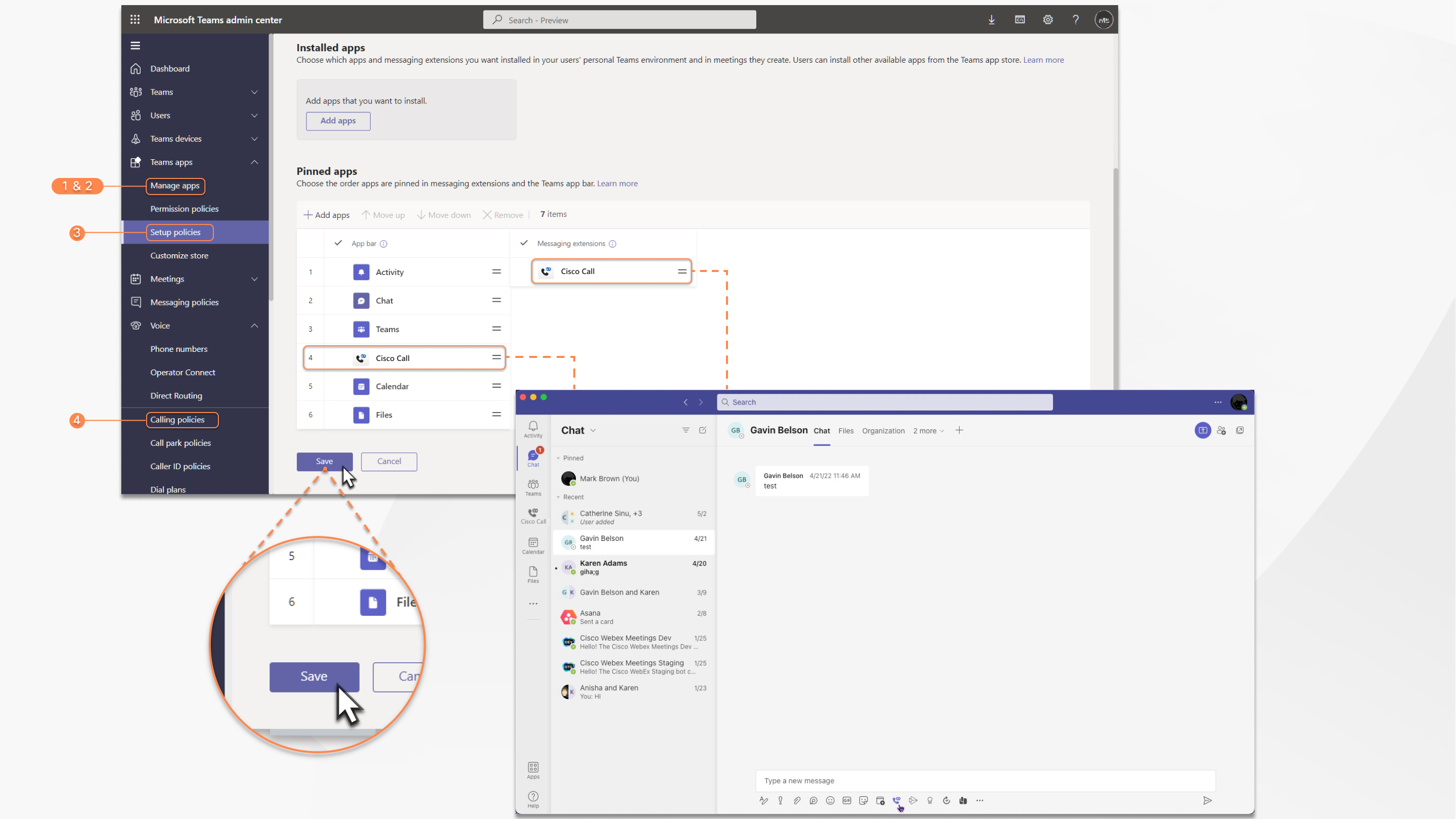
| 1 |
アプリを管理し、Cisco Call を許可するには、 Teams 管理センター にサインインしてください。 |
| 2 |
Cisco Call をインストールできるユーザーを管理します。 |
| 3 |
Cisco Call をインストールし、Webex アプリにアイコンを追加して、組み込みの通話オプションのピン留めを解除します。 |
| 4 |
オプション - 組織全体で組み込みの通話オプションを無効にし、Cisco Call を唯一の通話オプションにします。
|
プレゼンス同期の権限を承認する
Microsoft Teams のプレゼンス同期権限を確認して承認し、Microsoft Teams と Webex 間でユーザーのプレゼンス ステータスを双方向に同期します。
プレゼンスの同期を維持するには、ユーザーは 90 日ごとに少なくとも 1 回は Cisco Call 統合を使用する必要があります。
| 1 |
ダッシュボード メニューで |
| 2 |
検索ボックスに |
| 3 |
権限 タブをクリックし、 管理者の同意を与えるをクリックします。 |
| 4 |
以下の権限が含まれているかどうかを確認します。
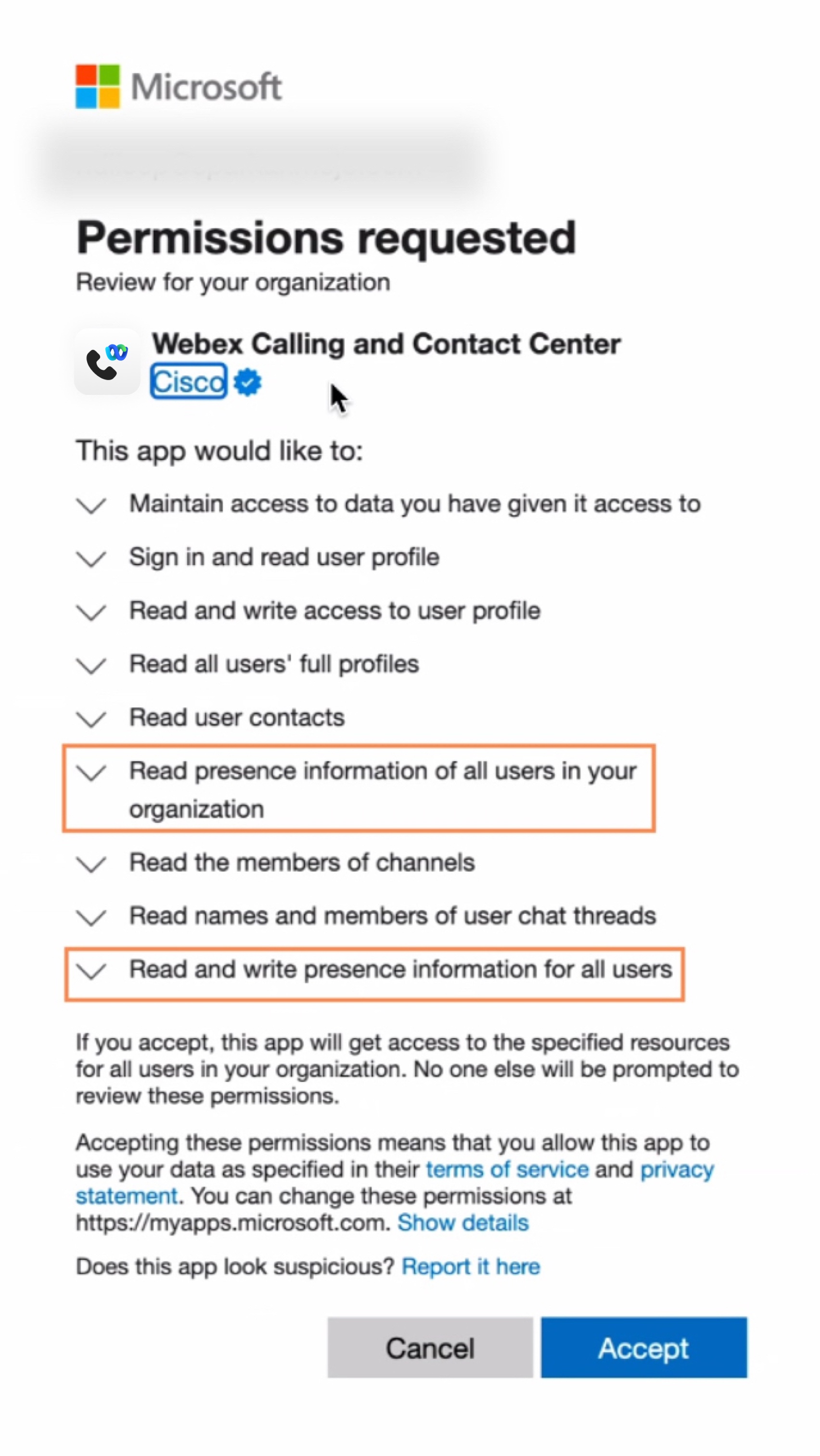 |
| 5 |
権限を承認するには、 [承認] をクリックします。 |
| 6 |
新しい権限が付与されていることを確認します。
管理者の同意では次の権限を遵守する必要があります。
組織で現在 権限を確認したら、コントロール ハブでプレゼンス同期を有効にします。 双方向プレゼンス同期を有効にする セクションを参照してください。 Microsoft Teams と Webex 間のプレゼンス同期ステータスに関する問題を回避するには、 割り当てが必要 設定を いいえに設定することをお勧めします。 設定を更新するには、Microsoft Entry管理センターまたはAzureポータルにアクセスし、 をクリックし、 いいえを選択します。 何らかの理由でこの設定を「はい」のままにしておく必要がある場合は、次の Microsoft ドキュメントに記載されている手順に従って、ユーザーを正しく割り当てるようにしてください。アプリケーションにアプリロールを割り当てる & アプリケーションへのユーザーとグループの割り当てを管理します。 |
Cisco Call アプリをカスタマイズする
組織のニーズに応じて、Microsoft Teams ユーザー向けの Cisco Call アプリを複数カスタマイズできます。すべてのユーザーに対してアプリのデフォルトのカスタマイズを作成することも、1 つのアプリの追加のカスタマイズを 10 個作成して、特定のユーザーまたはグループに割り当てることもできます。
詳細については、 Microsoft Teams ユーザー向けに Cisco Call アプリをカスタマイズするを参照してください。
Cisco Call と Microsoft Teams の統合の権限
統合サービスは、Webex と Microsoft API を使用して、集中化された通話履歴などのデータにアクセスし、ユーザー データを保存せずに、ボイスメールを既読としてマークするなどのステータスを表示および更新します。統合と Webex/Microsoft バックエンドは暗号化された HTTPS チャネルを介して行われます。これにより、このサービスではユーザーデータがクラウドに保存されないことが保証され、データのプライバシーとセキュリティが強化されます。
統合機能を有効にするために、Microsoft API を呼び出すために必要な最小限の権限を Microsoft に要求します。次の表では、要求する各権限とそれが必要な理由について説明します。
| 権限 | 理由 |
|---|---|
|
offline_access |
ユーザーに頻繁に再認証を求めることなく、統合サービスが新しいアクセス トークンを生成できるようにします。 |
|
User.Read |
統合サービスが電子メール アドレスなどのユーザーの基本情報を読み取ることを許可します。 |
|
ユーザー.読み取り書き込み |
統合サービスがユーザー プロファイルにスピード ダイヤルを保存できるようにします。 |
|
User.Read.All |
統合サービスがアクティブ ディレクトリ内のユーザーを検索して通話を行うことを許可します。 |
|
連絡先.読む |
統合サービスがユーザーの Outlook 連絡先を検索して電話をかけることを許可します。 |
|
ChannelMember.Read.All |
統合メッセージ拡張機能がチャネルのメンバーを読み取ることを許可し、ユーザーが特定のチャネル メンバーを検索して呼び出すことができるようになります。 |
|
チャット.ReadBasic |
統合メッセージ拡張機能によりグループ チャットのメンバーを読み取り、ユーザーが特定のメンバーを検索して電話をかけられるようにします。 |
|
プレゼンス.読み取り.すべて |
統合サービスがディレクトリ内のすべてのユーザーのプレゼンス情報を読み取ることを許可します。 |
|
プレゼンス.読み取り/書き込み.すべて |
統合サービスがすべてのプレゼンス情報を読み取り、ディレクトリ内のすべてのユーザーのアクティビティと可用性を書き込むことを許可します。 |
|
プレゼンス.読み取り/書き込み |
統合サービスがユーザーのプレゼンス情報を読み取り、アクティビティと可用性を書き込むことを許可します。 |
コントロールハブの構成
Control Hub で次の機能を構成し、有効にして、Microsoft Teams ユーザーが利用できるようにすることができます。
Webex アプリウィンドウを非表示にする
Cisco Call と Microsoft Teams の統合を使用することを選択した組織の場合、統合は Webex サービスへのユーザーの主要なインターフェイスになります。一度設定されると、Webex アプリはユーザーのコンピューターにインストールされ、実行されたままになりますが、そのウィンドウはデフォルトで閉じられます。Cisco Call 統合で実行されるアクションによって Webex アプリの特定の機能が起動する場合がありますが、通常、ユーザーが Webex アプリを操作する必要はありません。
Control Hub を使用すると、次のレベルで Webex アプリ ウィンドウを非表示にすることができます。
-
組織レベル
-
ユーザーグループレベル
-
ユーザー レベル
組織の Webex アプリ ウィンドウを非表示にする
組織レベルで構成された設定は、組織内のすべてのユーザーに自動的に適用されます。
| 1 | |
| 2 |
。 |
| 3 |
Webex アプリ タブをクリックし、 Microsoft Teams 統合 セクションに移動して、 Webex ウィンドウを非表示にするをオンに切り替えます。
また、パブリック API を使用して、Cisco Call と Microsoft Teams の統合を使用する組織内のすべてのユーザーに対して Webex アプリ ウィンドウを非表示にすることもできます。詳細については、 developer.webex.com の組織の MS Teams 設定の更新を参照してください。 |
ユーザーグループの Webex アプリ ウィンドウを非表示にする
ユーザー グループの Webex アプリ ウィンドウを非表示にするには、通話テンプレートを作成し、それをユーザー グループに割り当てます。テンプレート内の構成は、グループ内のすべてのユーザーに適用されます。
Webex アプリ ウィンドウを非表示にする新しいテンプレートを作成するには:
| 1 | |
| 2 |
。 |
| 3 |
テンプレートの作成をクリックし、 テンプレートの作成 を選択して、 次へをクリックします。 教育がビジネスの垂直分野である場合は、生徒または教師向けのカスタム設定を含む 定義済みテンプレート を適用できます。 |
| 4 |
全般 セクションで、 テンプレート名 と 説明を入力します。 |
| 5 |
Microsoft Teams 統合 セクションに移動し、 Webex ウィンドウを非表示にするをオンに切り替えます。 |
| 6 |
[テンプレートの 作成] をクリックし、[次へ] をクリックします。 |
| 7 |
このテンプレートのグループを検索して選択し、 完了をクリックします。 テンプレートを変更または削除します。
テンプレートを変更するには、テンプレートをクリックし、トグルを変更して、 保存をクリックします。 テンプレートを削除するには、テンプレートをクリックし、 アクション ドロップダウン リストから 削除 を選択します。 テンプレートの削除 ページで、テンプレートの削除が永続的であることを通知するボックスをオンにして、 削除をクリックします。 |
通話テンプレートをユーザーグループに適用する際の考慮事項
-
ユーザーが組織にオンボードの場合、ユーザーは組織レベルから設定を継承します。
-
ユーザーがユーザー グループに追加される場合、通話テンプレートからの設定が適用されます。
-
ユーザーが複数のユーザー グループに属している場合は、最高ランク (ランク 1) のテンプレートが最優先となり、そのテンプレートの設定が適用されます。
-
ユーザーに個別のユーザー設定がある場合、これらの設定はユーザー グループまたは組織レベルの設定よりも優先されます。
テンプレートの管理の詳細については、 設定テンプレートの構成 を参照してください。
既存のテンプレートは、 グループ セクションまたは 通話 セクションから適用できます。
- グループ セクションからテンプレートを適用するには、 設定テンプレートの構成を参照してください。
- 通話セクションから応募するには、次の手順を実行します。
| 1 | |
| 2 |
。 |
| 3 |
既存のテンプレートの横にある |
| 4 |
テンプレートを適用するグループ名を入力し、グループを選択します。 |
| 5 |
[完了] をクリックします。 |
ユーザーの Webex アプリ ウィンドウを非表示にする
個々のユーザー設定は、組織レベルおよびユーザー グループ レベルの設定よりも優先されます。
| 1 | |
| 2 |
。 |
| 3 |
ユーザーを選択し、 通話をクリックします。 |
| 4 |
ユーザー通話エクスペリエンス に移動し、 Microsoft Teams 統合をクリックします。 |
| 5 |
Webex ウィンドウを非表示をオンにします。 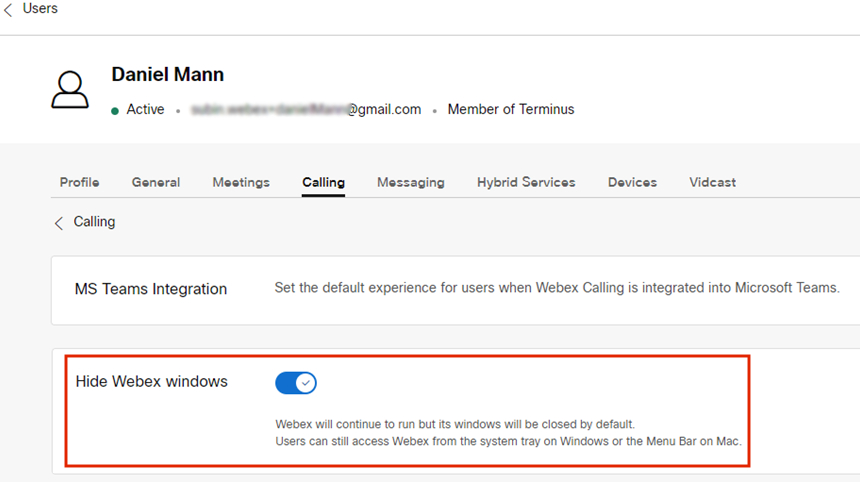 ユーザーの設定を構成したら、ユーザーレベルでさらに設定を変更できます。ユーザー設定は組織のデフォルト設定に自動的には戻りません。 パブリック API を使用すると、個々のユーザーの Microsoft Teams クライアントから Webex アプリ ウィンドウを非表示にすることができます。 developer.webex.com の ユーザーの MS Teams 設定を構成する およびユーザーのアプリケーション サービス設定を取得する を参照してください。 |
設定が完了したら、ユーザーは Webex アプリを再起動し、サインインして変更を確認する必要があります。
ユーザーが Webex アプリ自体を操作したい場合は、Windows のシステム トレイまたは Mac のメニュー バーからアクセスできます。Webex アプリは、ウィンドウがアクティブで使用中の場合にのみ、Windows タスクバーまたは macOS ドックに表示されます。
|
Webex アプリ Windows システム トレイ内 |
Webex アプリ Mac メニューバー |
ドックウィンドウの呼び出しを有効にする
通話ドック (複数通話) ウィンドウは、ユーザーが 1 つのウィンドウで複数または共有の回線を管理するのに役立つ、独立したフローティング ウィンドウです。ユーザーは、別のウィンドウに切り替えることなく、通話の発信や受信、すべての回線の状態の確認、保留、転送、割り込みなどの機能へのアクセスを容易に行うことができます。
| 1 | |
| 2 |
。 |
| 3 |
Webex アプリ タブをクリックし、 通話中の機能アクセス セクションに移動して、 追加機能で 通話ドックの表示 をオンにして、次のいずれかのオプションを選択します。
この機能は、ユーザー グループ レベルおよびユーザー レベルでも設定できます。
|
Webex アプリを Microsoft Teams エクスペリエンス向けに最適化
この機能により、ユーザーには次のエクスペリエンスが提供されます。
-
簡素化された通話設定 - 通話設定には、統合に必要なオプションのみが表示されます。この機能を有効にすると、通話ドックからアクセスできる通話設定のみが簡素化されます。Cisco Call 統合からアクセスできる通話設定は、デフォルトで簡素化されたままです。
-
Cisco 通話をミュートする - ユーザーが Microsoft Teams 通話または会議中の場合、着信 Cisco 通話はミュートされます。この機能が動作するには、Control Hub でこの機能を有効にし、ユーザーが Cisco Call 統合の通話設定から 会議中または通話中のときのみ通知をミュートする オプションを有効にする必要があります。
Control Hub でこの機能を無効にすると、ユーザー設定はユーザーが Cisco 通話または会議に参加しているときにのみ機能します。この機能を有効にすると、ユーザーが Microsoft Teams の通話または会議、あるいは Cisco の通話または会議に参加しているときに、ユーザー設定が機能します。
-
単一アプリ エクスペリエンス - ユーザーが通話ドックからボイスメールと集中通話履歴のアイコンをクリックすると、Webex アプリではなく Microsoft Teams Cisco Call にリダイレクトされます。
Windows ユーザーの場合: システム トレイの Webex アプリをクリックすると、Webex アプリではなく通話ドックが開きます。
| 1 | |
| 2 |
。 |
| 3 |
Webex アプリ タブをクリックし、 Microsoft Teams 統合 セクションに移動して、 Microsoft Teams エクスペリエンス向けに Webex アプリを最適化するをオンにします。
通話中の機能アクセス セクションの 通話ドックの表示 トグルを有効にしていない場合、このトグルは無効になります。 この機能は、ユーザー グループ レベルおよびユーザー レベルでも設定できます。
|
ボイスメール、通話履歴の集中管理、プレゼンスの同期を有効にする
ボイスメールと集中化された通話履歴
Webex Calling、専用インスタンス、および UCM Cloud のお客様では、ボイスメールと集中通話履歴機能がデフォルトで有効になっています。
Webex Calling ユーザーのボイスメールを有効にする方法の詳細については、以下を参照してください。Webex Calling ユーザーのボイスメール設定を構成および管理します。
BroadWorks ユーザーのボイスメールを有効にする方法の詳細については、 Microsoft Teams 統合のボイスメールの有効化を参照してください。
この機能が正しく動作することを保証するために、BroadWorks 管理者は統合された集中通話履歴を有効にする必要があります。詳細については 、Webex for Cisco BroadWorks 設定ガイド を参照してください。
双方向プレゼンス同期
この機能により、Microsoft Teams と Webex 間のプレゼンス ステータスの双方向同期が可能になり、同じ Webex 組織内の複数の Microsoft Teams テナントがサポートされます。プレゼンス ステータスには 、通話中、 会議中、 プレゼンテーション中、 応答不可が含まれます。
この機能を有効にすると、ユーザーが Webex 通話を発信または受信すると、Microsoft Teams のステータスが 通話中に変更されます。Webex アプリまたは任意の Webex デバイスで 応答不可 を有効にすると、そのステータスは自動的に Microsoft Teams に同期されます。同様に、 会議中 および プレゼンテーション中 のステータスもアプリケーション間で同期されます。
ユーザーの Webex アプリまたは任意の Webex デバイスで 応答不可 が有効になっている場合、Webex アプリ、Webex デバイス、または Microsoft Teams で着信通話やメッセージの通知は表示されません。
パブリック API を使用して、Webex プレゼンスと Microsoft Teams クライアントの同期を有効にすることもできます。詳細については、 developer.webex.com の組織の MS Teams 設定の更新 を参照してください。
次の表は、Webex と Microsoft Teams 間の双方向ステータス同期の表現を示しています。
|
Webex サービス状況 |
Microsoft Teams のステータス |
|---|---|
|
|
|
|
|
|
|
|
|
|
|
|
現在、この機能は組織レベルでのみ構成できます。
| 1 | |
| 2 |
。 |
| 3 |
Webex アプリ タブをクリックし、 Microsoft Teams 統合 セクションに移動して、 プレゼンス同期をオンに切り替えます。 最適なエクスペリエンスを得るために、 Webex ウィンドウを非表示にする トグルをオンにすることもできますが、これはオプションです。 |
| 4 |
[サイレントモード (DND) ステータス同期 ] セクションに移動して、トグルをオンにします。 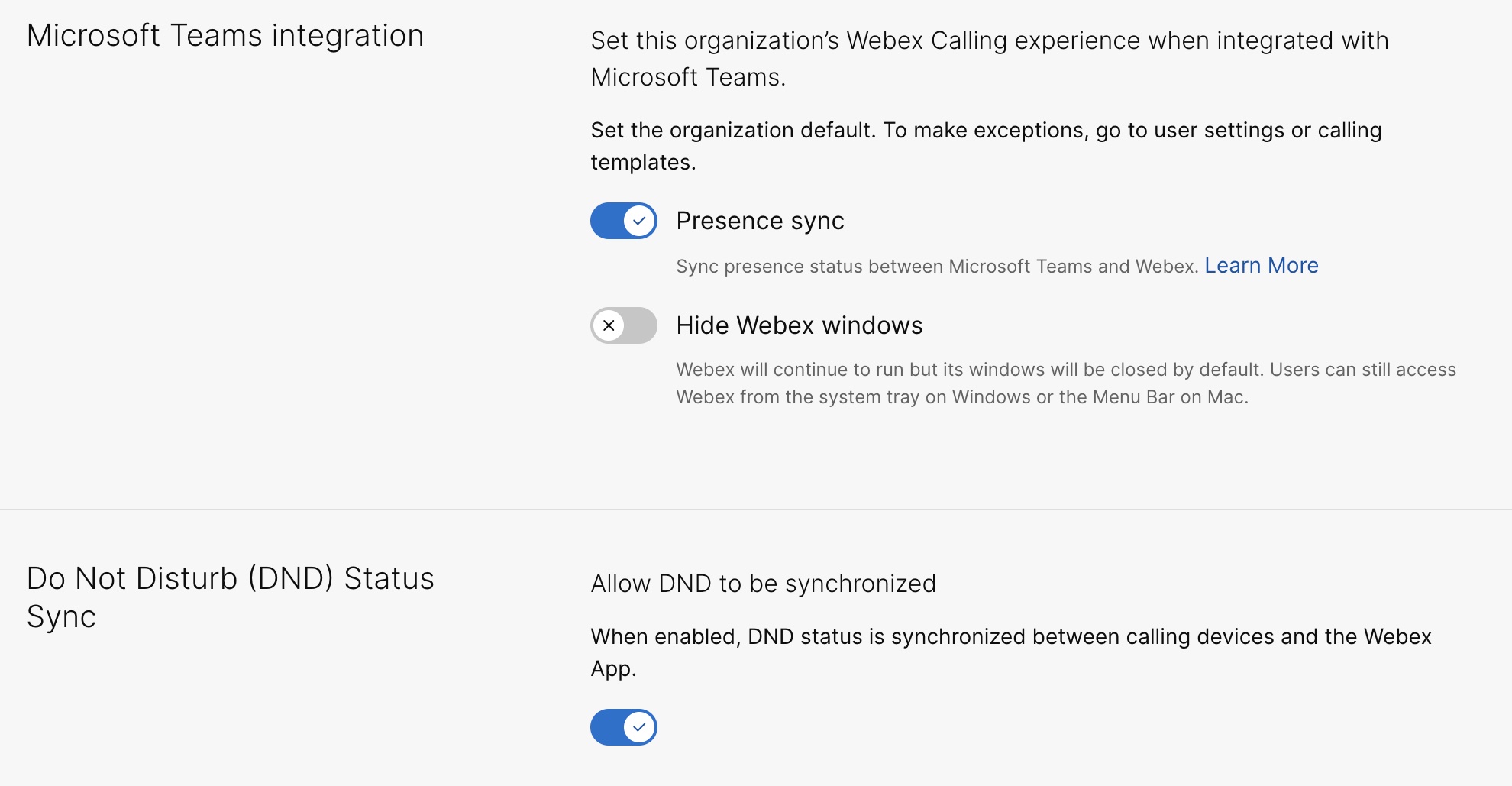 |
Unified CM ユーザー向けの追加設定
オンプレミスの Unified CM 顧客向けにボイスメール、集中通話履歴、双方向プレゼンス同期サービスを有効にするには、次の手順を実行します。
オンプレミスの顧客向けにボイスメール サービスを有効にするには、最大 12 時間かかります。
| 1 | |||||
| 2 |
。UC 管理カードで、[インベントリ] をクリックします。 説明、ステータス、クラスタ、ノードを含むクラスタ グループの一覧が表示されます。 | ||||
| 3 |
次のアクションを実行します。
選択したクラスタ グループに属するクラスタの一覧を含んだ [インベントリ] ページが表示されます。 | ||||
| 4 |
特定の製品のノードが属するクラスタの隣にある [詳細] をクリックします。 バージョン、製品、ステータスを含むノード名が表示されます。 | ||||
| 5 |
[イベント履歴] の横にある省略アイコン⋮をクリックし、[サービス管理] を選択します。 [サービス管理] ページにサービスの一覧が表示されます。 | ||||
| 6 |
トグルボタンを使用して、 ボイスメール、 集中通話履歴 、および プレゼンスステータスの同期を有効にします。
| ||||
| 7 |
[送信] をクリックします。 | ||||
| 8 |
データ収集確認 ポップアップが表示された場合は、チェックボックスをオンにして同意し、 送信をクリックします。 |

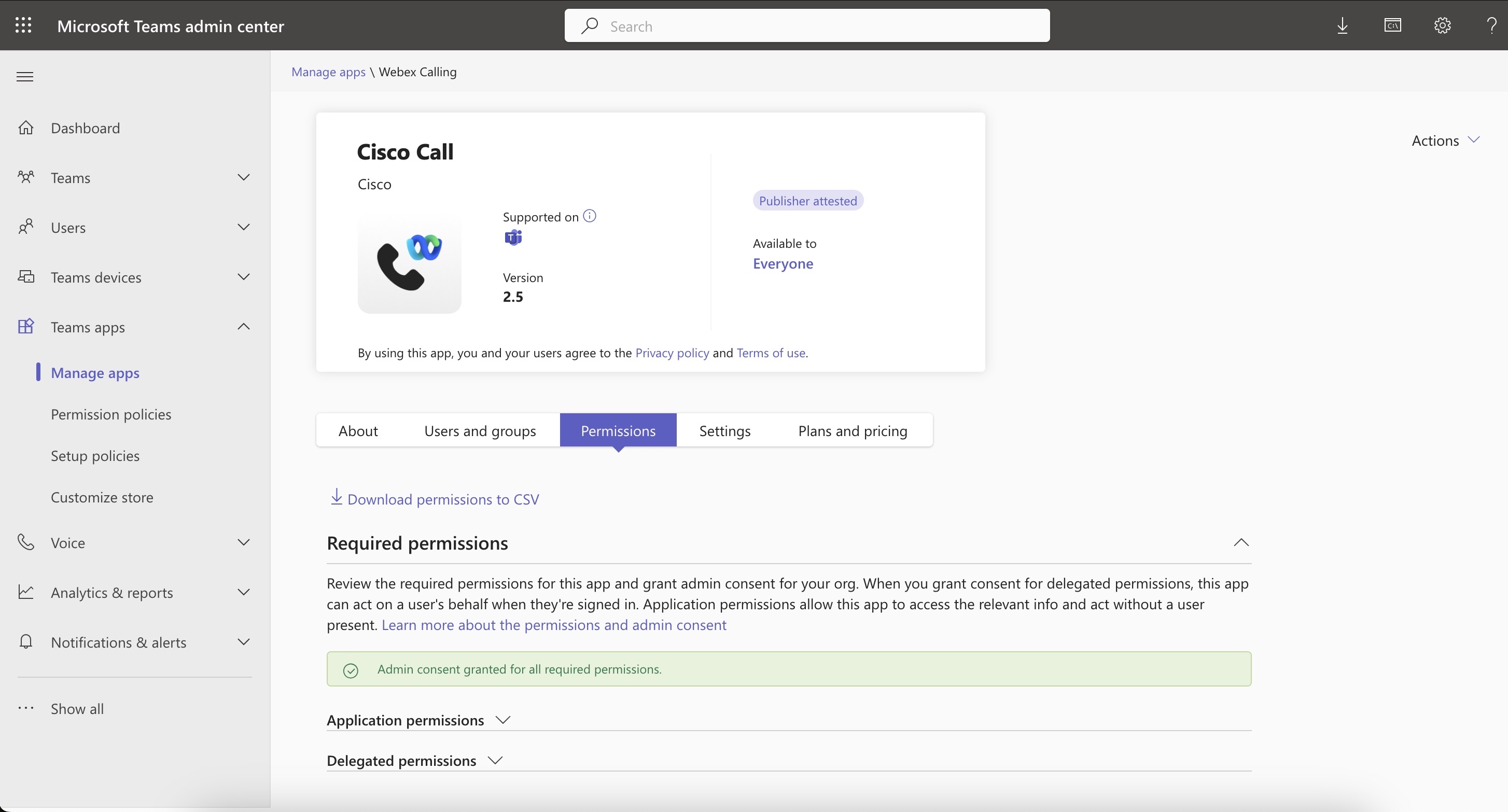
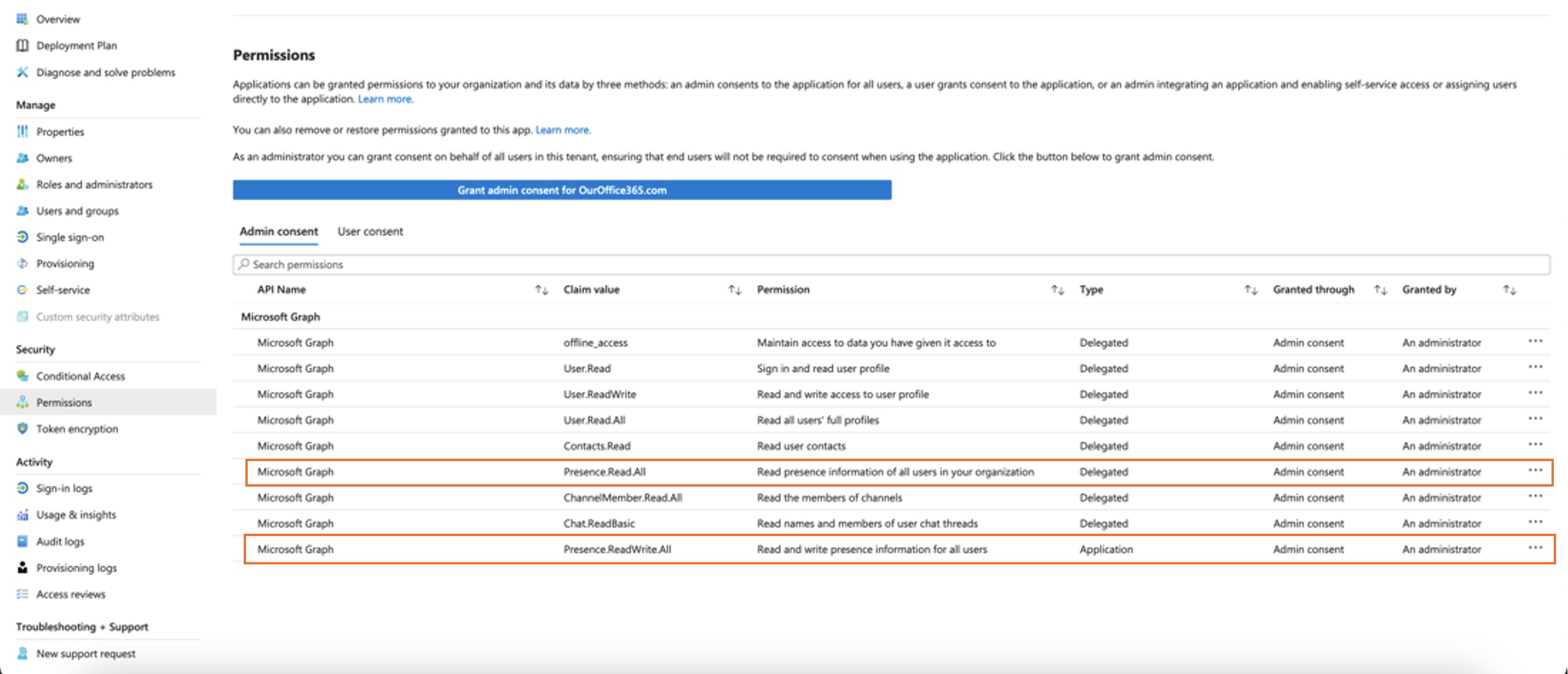
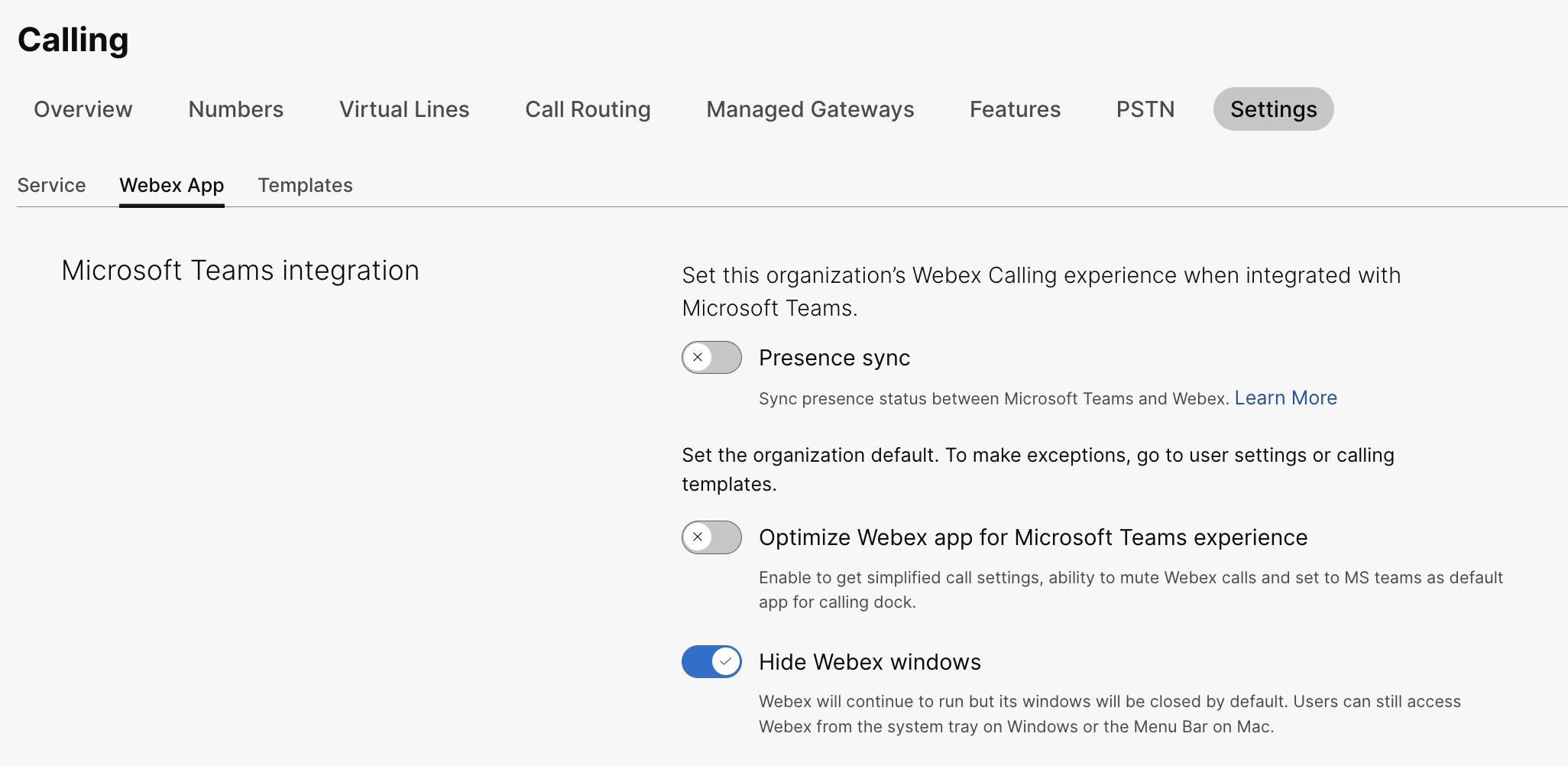
 をクリックし、
をクリックし、 